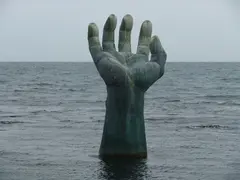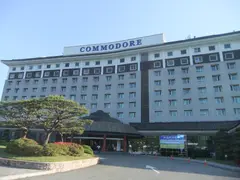
A very busy day. We got taken to see a National Treasure Buddha at Seokguram in a grotto up a mountain (only it wasn't a real cave more a dome) - along with the usual friendly school children who wanted to practise their English on us. The granite Buddha was behind a glass screen which only Buddhists were allowed to enter to pray with the help of a monk tapping a wooden soundbox. The climb and descent (Korea is very mountainous so we have faced numerous hills) was enlivened by striped squirrels which appealed both to us and the Asians. A Mr Kim accosted me on the way down, he seemed concerned I knew Seokguram and Bulguksa were both built by a prime minister seeking to honour his parents in a previous life and this life - I think but I excused myself pleading I needed to follow my fellow coach party.
We then went to see where a King Munmu had himself buried at sea - not a lot to see but sea and some rocks called Daewang-am. There were people selling dried seaweed and fish but we had plenty of that at our next stop - Guryongpo (Nine Dragon Port) which is a major fishing port built up by the Japanese. A Japanese street has been preserved, the Japanese who left Korea in 1945 still regard Guryongpo as home. Down the street a woman had a small white dog with its tail dyed a vicious orange. Wrong just plain wrong. Guryongpo was full of tanks of fish and squid and octopi and crabs (the largest being King Crabs from Russia on sale for 70,000 won) awaiting their doom. It also had coffee bars (Korea seems to be full of coffee bars) but our guide told us these were girly coffee bars for the fishermen. Our helpful guide assisted some of us to a Korean lunch I had something along dim sum lines. On the TV was showing an episode of the Korean TV drama "Mirror of the Witch" which my fellow travellers didn't appreciate the cheesy melodrama.

The coach then drove to Homigot near Pohang and a cove called Homigot Sunrise Square or Tiger's Tail, where many Koreans watch the sun rise at the start of the new Lunar Year. The local government provides rice cake soup for them in a massive cauldron. There was a giant hand artistically in the sea, one flame still going from the start of the new millennium, an octopus sculpture to admire, a souvenir shop where I got Virginia a scarf, and a Millennium Exhibition which included a display of rocks similar to what I've seen in China. Koreans share some passions with Chinese and Japanese, they also have bonsai.
The highlight of the day for me was the visit to Gyeongju Seongdong Market arcades, an overdose of foods from pulsating sea cucumber through to rainbow coloured desserts on sale in a warren of passageways. Our guide bought a tasty multicoloured snack, I fell for a rainbow snack which looked like and tasted like kitchen wipes! The Koreans have a variety of melon which is stripey. Our last stop was a small Buddhist temple Gulbulsa which has a Buddha sculpture facing in many directions. It's a small poor temple, few lanterns with hanging up, whereas the big temples have loads of money.

I did try to eat out in the evening, but getting turned away from one place (I don't blame them as if we couldn't communicate it wouldn't be fun for anyone) I resorted to eating in the hotel's Japanese restaurant. I've never had tempura before with kimchi - I made the mistake of finishing the kimchi before the main dish arrived only for them to refill the bowl of kimchi! I had to have some more to not make them lose face. The Commodore Hotel have gone up in my estimation - they provided two new bottles of water, and they have a convenience store conveniently in the basement. Very handy.